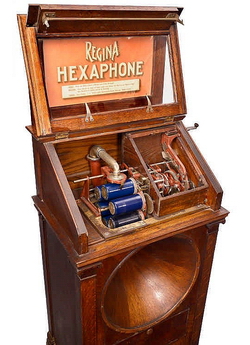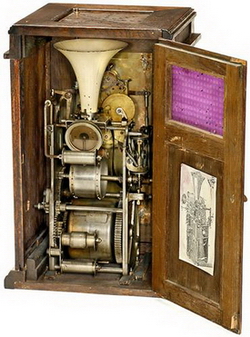|
Collecting Cylinder Phonographs in Quebec
by Jean-Paul Agnard
Pathé Celeste

|
|
Since that day back in 1970 when
I acquired my first cylinder
phonograph at an antique shop in
Quebec City, I have had numerous
occasions to search throughout the world for more. I must say that if
Quebec is not the worst place (I spent 5 years in
Morocco and found only one machine, even if it was an
exceptional one), it is not the best place either for a
phono-sarafi.
It is not surprising that my first machine
was an Edison Standard Model D, because this
kind of machine was very popular at that time in this
province, particularly the one from the
International Correspondence School of Scranton,
Pennsylvania, for learning English. At that time it was a must if you
wanted to upgrade your position in society or emigrate to
New England to find work. When they are not Edison
Standards, the cylinder machines you find are Amberolas
Xs and 30s, Homes, seldom Gems, but
never Triumphs, Operas, Class M or, much less, Idelias.
Usually you can also find Columbia BKs, Bs or Qs, and
nothing else. But sometimes through a stroke of luck
I have found something else. It has struck four times during my 28 years of collecting.
Regina Hexaphone

|
|
The first extraordinary machine found by
me in Quebec was a Celeste made by Pathé in 1900. It was the
only type of cylinder machine sold to the
public to play the unique Celeste cylinder
of Concert diameter, but twice as long at
8.5". Originally it had been the property of
the Cyclorama of Jerusalem, located in
Ste-Anne-de-Beaupre. Its last owner,
a native of Ste-Anne, was living 450 km from there with
the machine, 5 Concert and 1 Celeste
cylinder. The rest of the cylinders, 80 Concert and 4 Celeste,
were still in the Cyclorama building. After several
negotiations all of them joined the collection.
Hiller talking clock

|
|
The next year a young visitor told me that his father in Montreal had a
non-working cylinder machine with 6 cylinders in his basement.
It was a Regina Hexaphone, made after 1908, that we
acquired after several discussions and a memorable trip to
Montreal during a snow storm, to be sure of not losing it
to another collector. Inside there were several Edison
Blue Amberol cylinders of the 5000 series, electrically
recorded and issued in 1928.
Four years ago I found a Hiller talking clock in an antique
shop on hwy. 20 between Quebec City and Drummondville.
300 of these were made from 1910 in Berlin. The
phonograph is located under the clock mechanism and announces the hour,
quarter and half hour with a Pathe type sapphire
reproducer for vertical cut recording. A celluloid ribbon with 48
grooves moves by means of perforations, as on 35mm
film. With 40" of length, this ribbon can be assimilated to
a cylinder of 12.75" diameter.
Finally, near Sherbrooke last year, I was
lucky enough to buy one of the masterpieces
of my collection - a large (5.75" in diameter
and length) original tin foil phonograph.
Its last owner was of German origin
and a friend of one of Berliner’s sons. He told
me that this machine had been made by Emile Berliner himself, while
experimenting at the very beginning of sound recording,
before his experiments with the lateral cut method.
I am soon expecting to have proof of its origin. If this turns out to
be true, I can definitely assert that miracles do exist, especially
for those living near the Ste. Anne basilica!
|